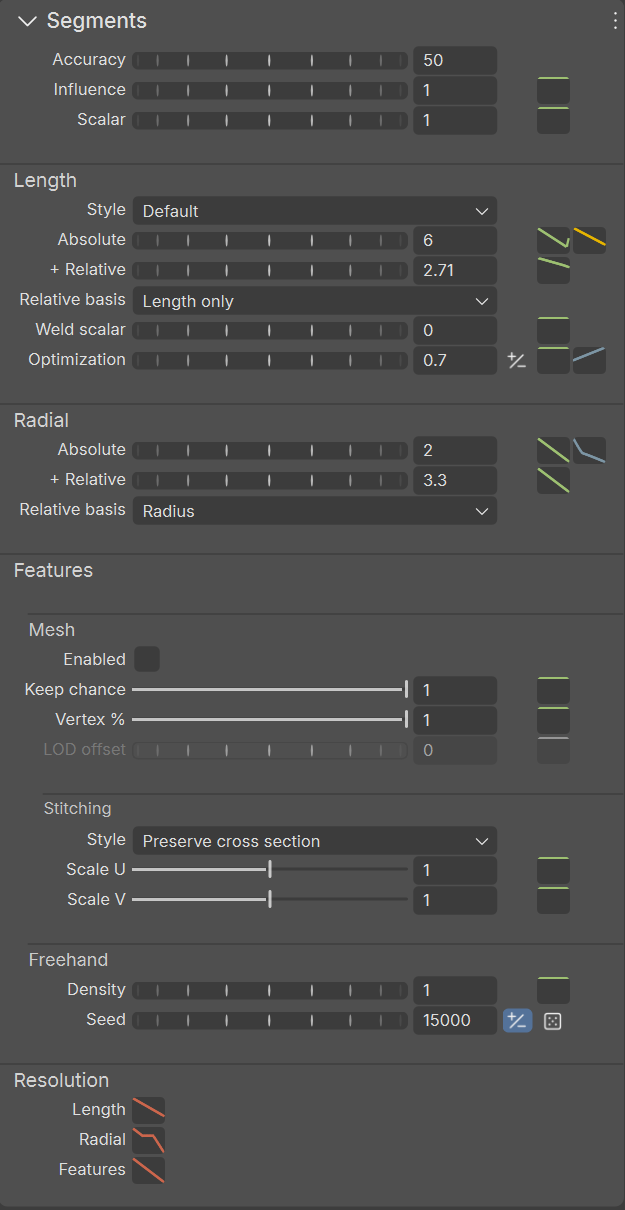Resolution
Resolution is the mechanism by which you can quickly control the polygonal complexity of a model.
A single model now exists in any of four resolution states (High, Medium, Low, and Draft), and you can switch between them simply by clicking one of the buttons on the viewport toolbar. The goal of this system is to allow you to export the model at a polygon count that matches the needs of your shot without making permanently destructive edits or synchronizing edits across several models. There is one model to maintain but you can export it how you see fit. [!NOTE] The best workflow is keeping resolution set to "High" and using the other resolutions for exporting lower detail versions and accelerating complex computations (e.g., wind editing).
Changing resolution
To change resolution, click on one of the four buttons in the "Resolution" group on the viewport toolbar (pictured below).

When you change resolution the model will recompute from scratch. Any properties that have a corresponding resolution curve will adjust to the new setting. So, properties like Branch Length Segments, Branch Radial Segments, and Leaf Mesh LOD will all be affected by a resolution change.
Resolution curves
Most properties that affect polygonal resolution have corresponding resolution curve properties. They're marked by their orange color and resolution markings in the curve editor. For example, look at the "Segments" group on the branch generator (pictured below).

The "Segments:Resolution:Length" and "Segments:Resolution:Radial" properties are curves that modify the length and radial segments based on the currently selected resolution. To edit these properties, select the curve and the Curve Editor will open.

Each of these Curve Points control the polygonal count for the corresponding resolution.
You can find multiple curves throughout the generator's properties that control the setting of the resolution triangle count. Some of the curves decrease the segment count, others take away objects (e.g., "Generation:Knockout:Resolution"). There are even properties that enable/disable entire generators.
Hint: Consult the pertinent generator documentation for a complete description of what each resolution curve does.
As an example, let's examine the "Length Segment" resolution curve for the Branch generator pictured above. Every branch created by that generator will compute its length segments based on what is set on the regular segment properties. Then that number will be multiplied by the value of the curve at the current resolution setting. For example, if a branch needed 60 length segments and the resolution was set to "Medium," the actual segment count used would be 60 x 0.75, or 45.
Note
Resolution curves mean that sometimes the numbers you type in aren't used directly where segments are concerned. If you want exactly 20 radial segments but you're only getting 14, look to the resolution curve for the reason.
You are free to modify any resolution curve as you see fit. If a particular resolution's polygon count is too high or too low you can target individual parts of the model and change them by editing any of the resolution curves.
Best practices
The following list outlines a few things to keep in mind when tuning model resolutions.
If you don't care about changing resolutions, keep it on "High." All of your segment count numbers will be used directly and not scaled back by any curves.
Models created by SpeedTree are typically saved in "Medium" resolution. This is so you can go up or down in polygon count as you see fit.
Use the "Generation:Shared:Active" resolution curve to swap entire generators in and out based on resolution for radical changes (e.g., going from leaf maps with one leaf on them to leaf maps with five leaves).
Use Draft mode to drastically reduce triangle count when making a series of computationally intense edits (e.g., scrubbing the season slider).